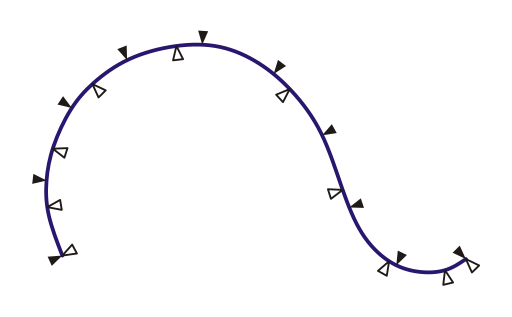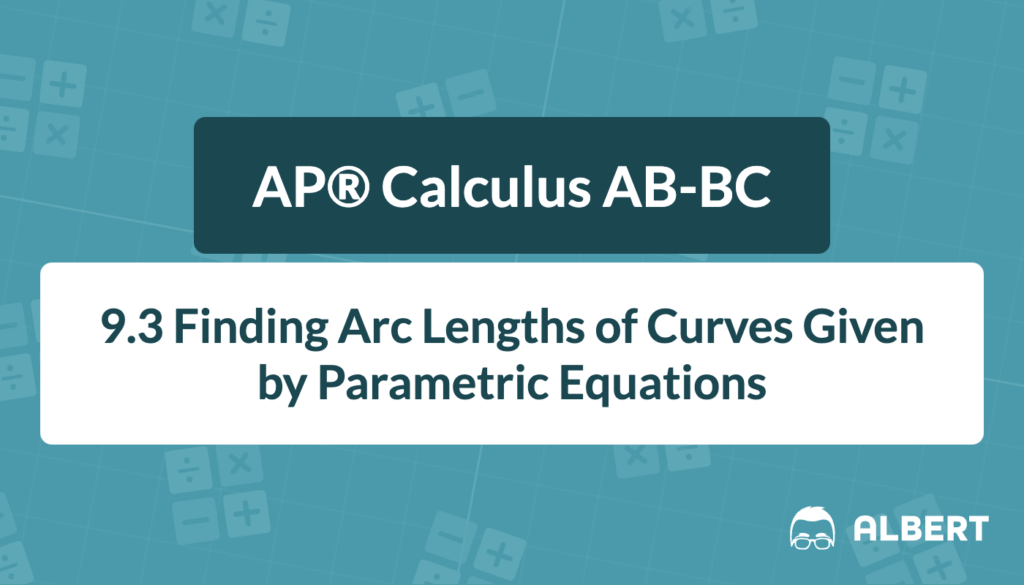Arc length of parametric equations is a core concept in AP® Calculus AB-BC. It helps determine the distance along a curve defined by two separate equations in terms of a parameter t. For instance, a car moving on a winding road can be described by parametric equations for its horizontal and vertical positions as time passes. Therefore, understanding arc length of parametric equations is valuable for tracking real-world motion.
Moreover, this idea connects directly to definite integrals. In particular, the total distance traveled by a point on a curve can be computed by integrating a formula involving the derivatives of the parametric functions. Consequently, the arc length formula serves as an important practical application of definite integrals.
What We Review
Revisiting Parametric Equations
Basic Definitions
Parametric equations come in pairs: x(t) and y(t). These two functions define a curve by relating both x and y to a shared parameter t, which often represents time. The parameter typically runs over an interval [a, b]. Over this interval, the graph traces out a particular path.
Think of x(t) and y(t) as describing horizontal and vertical motion, respectively. When t changes, the point (x(t), y(t)) moves along the curve.
Why Use Parametric Equations?
Sometimes, a standard function y = f(x) is not enough to capture a more complicated path. For example, when an object travels back and forth, describing that motion using a single equation in x and y can be cumbersome. However, parametric equations allow each coordinate to be expressed in terms of t, making it easier to model intricate or looping curves.
Furthermore, in situations involving physics, parametric equations help model position, velocity, and acceleration over time. Consequently, mastering parametric forms is helpful for deeper studies in calculus and beyond.
Arc Length Formula for Parametric Curves
The General Formula
The arc length formula for a curve defined by x(t) and y(t) over [a, b] in AP® Calculus AB-BC is:
L = \int_{a}^{b} \sqrt{\left(\frac{dx}{dt}\right)^2 + \left(\frac{dy}{dt}\right)^2}dtThis formula requires that \frac{dx}{dt} and \frac{dy}{dt} are continuous. Moreover, the expression under the square root must be non-negative to represent a valid distance.
Step-by-Step Derivation (Conceptual Explanation)
First, small elements of length along the curve are denoted by ds. In a tiny interval \Delta t, the point on the curve moves approximately \sqrt{\left(\Delta x\right)^2 + \left(\Delta y\right)^2}. Hence, taking the limit as \Delta t \to 0, the distance becomes:
ds = \sqrt{\left(\frac{dx}{dt}\right)^2 + \left(\frac{dy}{dt}\right)^2}dtThen, summing these small segments from t = a to t = b yields the definite integral for total arc length.
Importance in AP® Calculus AB-BC
This arc length concept appears in advanced calculus topics and is linked to the curriculum standard CHA-6.B.1. Therefore, students should become comfortable finding lengths via integrals—especially the arc length of parametric equations—ensuring a solid foundation for related applications like surface area and center of mass problems.

Worked Example #1: Straightforward Parametric Equations
Problem Statement
Find the arc length of the curve defined by x(t) = t and y(t) = t^2 over the interval 0 \leq t \leq 2.
Step-by-Step Solution
1. Find the derivatives:
- \frac{dx}{dt} = 1
- \frac{dy}{dt} = 2t
2. Substitute into the arc length formula:
- L = \int_{0}^{2} \sqrt{(1)^2 + (2t)^2}dt
- This becomes: L = \int_{0}^{2} \sqrt{1 + 4t^2}dt
3. Integrate carefully:
- To integrate \sqrt{1 + 4t^2}, consider a trigonometric or hyperbolic substitution if needed. Another method is to recognize it resembles the form \sqrt{a^2 + x^2}, which leads to a standard antiderivative.
- The antiderivative of \sqrt{1 + 4t^2} is \frac{t}{2}\sqrt{1 + 4t^2} + \frac{1}{4} \sinh^{-1}(2t) if using hyperbolic functions, but other methods can work.
4. Evaluate the result from 0 to 2:
- Substituting the bounds t = 2 and t = 0 into the antiderivative yields the exact arc length. Although a numerical approximation may be more practical, the exact form is acceptable for many calculus problems. With the final step, the expression simplifies but often stays in a form involving \sinh^{-1}.
Worked Example #2: More Complex Parametric Equations
Problem Statement
Compute the arc length for the parametric curve given by x(t) = 2\cos(t) and y(t) = 2\sin(t) on the interval 0 \leq t \leq \pi.
Step-by-Step Solution
1. Compute derivatives:
- \frac{dx}{dt} = -2\sin(t)
- \frac{dy}{dt} = 2\cos(t)
2. Substitute into \sqrt{\left(\frac{dx}{dt}\right)^2 + \left(\frac{dy}{dt}\right)^2}:
- \sqrt{(-2\sin(t))^2 + (2\cos(t))^2} = \sqrt{4\sin^2(t) + 4\cos^2(t)}
- Then, simplify inside the square root: \sqrt{4(\sin^2(t) + \cos^2(t))} = \sqrt{4} = 2
3. Set up and evaluate the definite integral:
- L = \int_{0}^{\pi} 2dt = 2 \cdot \left[t\right]_{0}^{\pi}
- Therefore, L = 2\pi.
4. Simplify the final expression:
- The result 2\pi signifies half the circumference of a circle with radius 2, which matches expectations since x(t)=2\cos(t), y(t)=2\sin(t) is a circle of radius 2.
Common Mistakes and Tips
- Double-check derivatives: A small oversight in \frac{dx}{dt} or \frac{dy}{dt} can lead to an entirely wrong result.
- Identify the correct interval: Make sure to use the interval [a, b] that actually traces the desired portion of the curve.
- Simplify under the radical: Often, there is a factor common to both squared derivatives that can be factored out before integration. Therefore, look for opportunities to reduce complexity.
Moreover, remembering the chain rule is essential when working with more involved functions. Additionally, try to confirm that the parameter t moves in the same direction over the intended path to match the problem’s domain.
Quick Reference Chart: Key Terminology
| Term | Definition |
| Parametric Equations | A pair of equations x(t), y(t) that define a curve by relating x and y to a parameter t. |
| Arc Length | The distance measured along a parametric curve over a given interval of t. |
| Derivative dx/dt | The rate of change of x(t) with respect to t. |
| Derivative dy/dt | The rate of change of y(t) with respect to t. |
| Definite Integral | An integral with set limits, used to calculate the total accumulation over an interval. |
Conclusion
In summary, the arc length of parametric equations is found by integrating \sqrt{\left(\frac{dx}{dt}\right)^2 + \left(\frac{dy}{dt}\right)^2} from t = a to t = b. This process aligns closely with the broader concept of using definite integrals to sum small distances over a curve. Mastery of derivative computations and interval identification ensures the correct result. Most importantly, understanding arc length for parametric curves provides a stepping stone to more advanced topics, such as vector functions and motion in higher dimensions.
Sharpen Your Skills for AP® Calculus AB-BC
Are you preparing for the AP® Calculus exam? We’ve got you covered! Try our review articles designed to help you confidently tackle real-world math problems. You’ll find everything you need to succeed, from quick tips to detailed strategies. Start exploring now!
Need help preparing for your AP® Calculus AB-BC exam?
Albert has hundreds of AP® Calculus AB-BC practice questions, free responses, and an AP® Calculus AB-BC practice test to try out.








